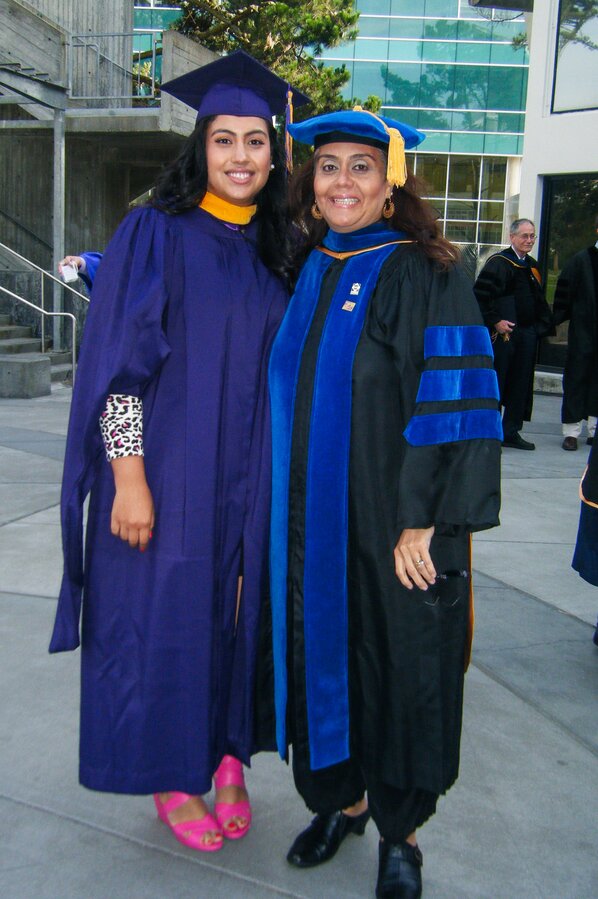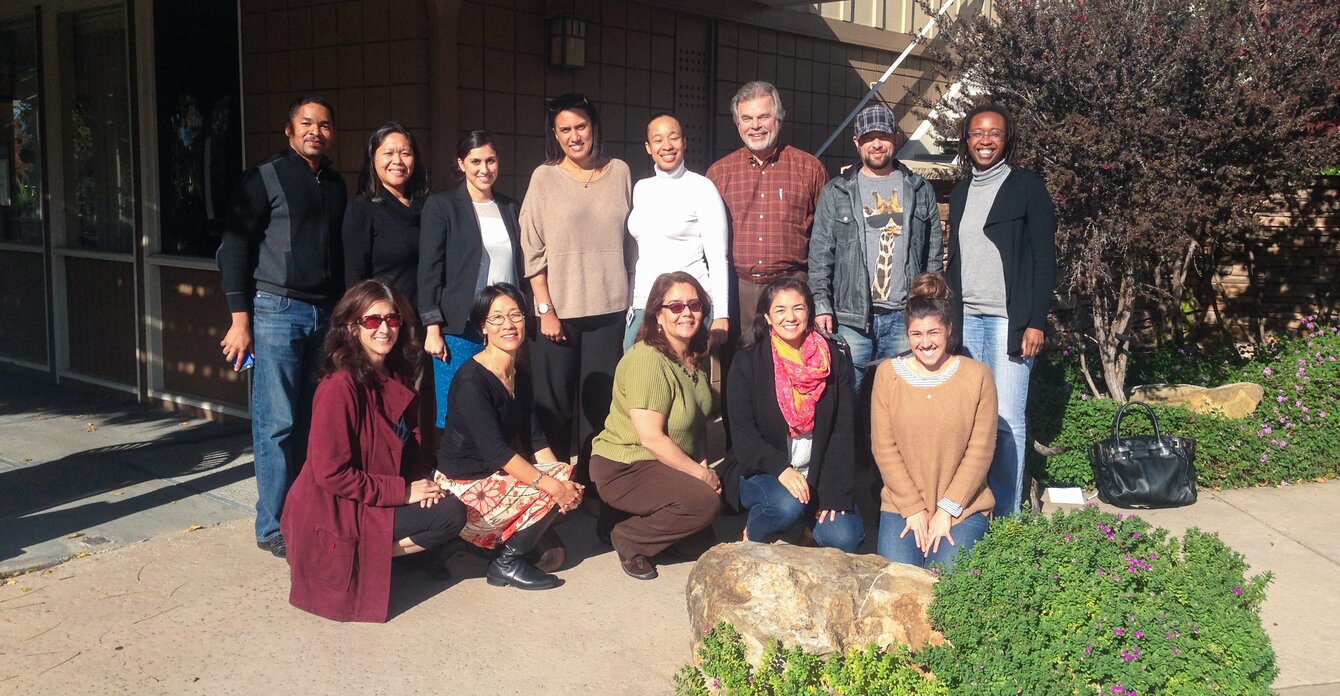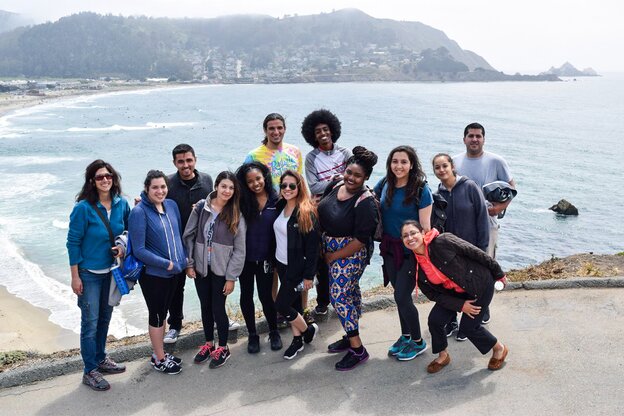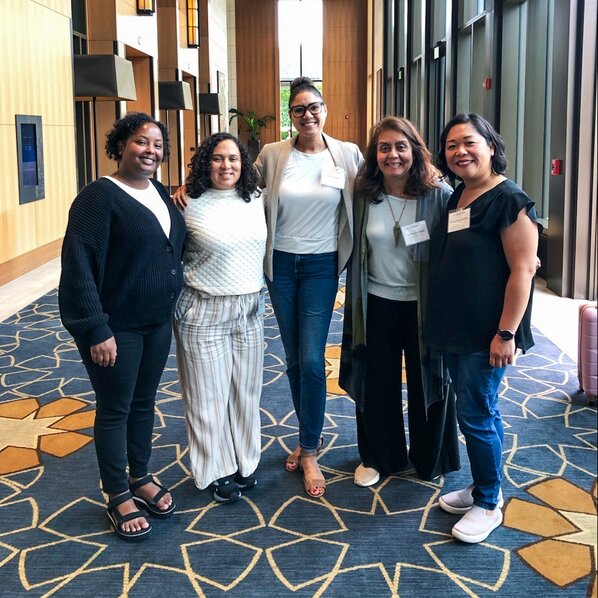SF BUILD leaders reflect on shifting institutional cultures for change
By Leticia Márquez-Magaña and SF BUILD leadership team
When the BUILD undergraduate research training program launched at San Francisco State University (SF State) in 2014, the use of deficit-based approaches to address diversity issues in science was commonplace.
These approaches yielded only modest success, according to SF BUILD principal investigator Leticia Márquez-Magaña, PhD.
“There is evidence in the literature that data was interpreted with bias and exaggerated to make the case that individuals from historically underrepresented groups are less than,” Márquez-Magaña said.
Instead, the *literature showed that underperformance and/or exit from science of minoritized students could be otherwise explained. For example, poor teaching, which negatively affects all science students, was found to especially curtail the success of minoritized students. Psychosocial factors like stereotype threat (often triggered by microaggressions) and inattention to creating a culturally-affirming environment were also found to be barriers.

Cathy Samayoa, MS, with her thesis committee chair, Leticia Márquez-Magaña, PhD, at her graduation ceremony in 2011.
Cathy Samayoa, PhD, an assistant professor of biology at SF State and a former SF BUILD postdoctoral fellow, said she felt these barriers while pursuing her STEM education.
“My perception was that I was going to have to change who I was to fit into science,” Samayoa said in 2011, while she was a master’s student in cell and molecular biology.
Samayoa’s perspectives as an undergraduate and masters student informed the design of the intervention, according to Márquez-Magaña. She has served many roles in the program: as a post-doctoral fellow in the HER lab funded by SF BUILD, leader of STC, and she was hired for her current role as a professor through the Health Equity Researcher position sparked by SF BUILD efforts to shift research in biology towards a equitable approach.
The SF BUILD team aimed to develop a project that enabled science students to bring their ‘whole selves’ into science. The ideas for proposed activities came from minoritized faculty who were experts in multiple science disciplines at SF State, and one expert in medicine and epidemiology at the University of California, San Francisco (UCSF), which became a research partner institution for the BUILD program.
These individuals not only were compelled by the evidence that deficit-based approaches focused on “fixing the student” often fail, but they also had their own lived experiences as minoritized student trainees. Some were able to experience ‘intellectually safe spaces’ while they were undergraduates and wanted to provide something similar to BUILD student trainees.
For example, Teaster Baird, Jr., PhD, former Co-Director of SF BUILD’s student training core and the current associate dean of the College of Science and Engineering at SF State, said he experienced a “campus-wide intellectually safe space” when he attended Tougaloo College, a historically black college/university.
“Whether in advanced math courses or organic chemistry, the affirmative support and the challenge [without threat] by the faculty encouraged excellence,” Baird said.
As an undergraduate, SF BUILD principal investigator Leticia Márquez-Magaña, PhD, lived in Casa Zapata, the Chicano-themed dorm at Stanford University. She said this allowed her to cope with the everyday “intellectual threats” on the main campus and to embrace being “Chicana/Latina and a scientist.”
Institutional transformation to Enable Full Representation in Science
The SF BUILD planning team members recognized the need to “fix the institution.” They decided to focus the SF BUILD intervention on mitigating stereotype threat and using asset-based (culturally-affirming) approaches.
Their intervention sought to affirm the values of minoritized students and their desire to “give back” to transform biomedical research for the benefit of all. This ability to give back was central to SF BUILD Co-Director Audrey Parangan-Smith, PhD, in her transition from basic science to science equity work.

Top row (left to right): Teaster Baird, Jr., PhD in Chemistry; Audrey Parangan-Smith, PhD in Microbiology; Neeta Thakur, MD; Kirsten Bibbins-Domingo, PhD MD MAS; Marquitta White, PhD in Human Genetics, Robert Hiatt, MD PhD; Avi Ben-Zeev, PhD in Cognitive Psychology; and Tendai Chitewere, PhD in Anthroplogy. Bottom row (left to right): Carmen Domingo, PhD in Developmental Biology; Irene Yen, MPH PhD; Leticia Márquez-Magaña, PhD in Biochemistry; Alegra Eroy-Reveles, PhD in Chemistry; and Holly Logan, Communication Specialist.
“I pursued a career in microbiology because I was fascinated with the regulation of complex bacterial cooperative behavior and how microbes can be used for environmental remediation,” Parangan-Smith said. “As I completed my PhD, I realized it was no longer my passion.”
Instead, she found meaning in her work to give back through postdoctoral training at her alma mater, SF State, through science education research.
“I wanted to empower students like myself to navigate the challenges of pursuing a STEM career, particularly as a woman of color,” she said. “I benefited from amazing mentors who helped me in my science journey. I wanted to similarly give back through mentorship and science equity research.”
SF BUILD leaders aimed to test their central hypothesis — that systemic efforts to create classroom and research environments that affirm the interests and values of students from underrepresented groups will increase their intent to pursue a biomedical research career. By shifting institutional cultures at SF State and UCSF to be more aligned with communal cultures of minoritized students, these students would be better retained in pathways to science and health careers. They also hoped that this approach could harness the community cultural wealth of many minoritized students to improve the rigor and impact of biomedical research and advance health equity.
SF State’s history supporting agents of change
The notion of transforming the institution for equity in higher education is not new at SF State.
As the site of the longest student-led strike in the United States, university’s actions in 1968-69 enabled “Agents of Change” (AoC) to advance higher education by, with and for people of color across the country.
However, SF BUILD leaders found that fields that comprise biomedical and behavioral research remained relatively unchanged. To remedy this societal neglect, the SF BUILD intervention sought to enable minoritized students to serve their communities as “insider researchers” for mutual benefit.
“Transformative research requires insider researchers, and training activities aimed at enhancing diversity must include insiders [leaders who share a common culture and language with trainees],” Márquez-Magaña said. “When assembling a team to put into gear the necessary changes for improving a flawed system, it is necessary to include those most affected by the design flaws.”

SF BUILD cohort 1 at the San Francisco coast
By adopting the intentional practice of advancing institutional transformation efforts by, with, and for minoritized groups in science, SF BUILD leaders hoped to extend the legacy of the student-led strike of the late sixties.
The SF BUILD project anchored its efforts to shift institutional culture by cultivating AoC. They developed and implemented programs for students, faculty, staff, and administrators that created AoC in science and health domains.
At UCSF, the White Coats for Black Lives protests in 2015 brought medical student AoC to the forefront of institutional change efforts. These protests, which took place at the beginning of the SF BUILD project, generated momentum to put into gear mandates for equity and inclusion. Ultimately, UCSF leaders committed to becoming the most diverse, equitable and inclusive academic institution in the country as a primary goal of its most recent strategic plan.
SF State and UCSF worked together to achieve this diversity goal.
“If you want minority students and trainees, you have got to go to where they are — in our case, San Francisco State University,” said Tung Nguyen, MD, Associate Vice Chancellor for Research Inclusion, Diversity, Equity, and Anti-Racism at UCSF and a co-principal for SF BUILD.
Evidence of institutional shifts

From left: Ekland Abdiwahab, PhD; Carol Umanzor, MS; Marilyn Thomas, PhD; Leticia Márquez-Magaña, PhD; and Audrey Parangan-Smith, PhD.
The SF BUILD team said the 10-year project has provided evidence of shifts in institutional cultures at both SF State and UCSF.
They point to the hiring of Samoyoa at SF State and Marilyn Thomas, PhD, at UCSF as examples. Both are “double Gators,” having earned undergraduate and master’s degrees at SF State and later completing post-doctoral fellowships at UCSF after obtaining their doctoral degrees elsewhere.
Both Samayoa and Thomas served as leaders on the SF BUILD project while working on their fellowships and honing their own and their mentees’ community cultural wealth for the benefit of biomedical research.
“Now, I see the value that I bring by showing up as my authentic self,” Samayoa said. Thomas added, “I now understand how critical it is to provide our talented rising scholars with rigorous and culturally relevant mentorship and support [because] their experiences and perspectives are essential to the biomedical sciences.”
Working together, SF State and UCSF have implemented the following multilevel interventions through the SF BUILD project to attain key outcomes that will sustain partnership efforts after the National Institutes of Health’sNIH funding comes to an end.
Learn more about SF BUILD’s interventions and outcomes below.
SF BUILD’s interventions and outcomes: Student, faculty and institutional levels
STUDENT LEVEL
Primary Intervention: Students are systemically affirmed by institutional practices and policies, inclusive and affirming teaching pedagogies, and "giving back" research experiences to develop their leadership as Agents of Change (AoC).
Key Outcomes:
- 97% of the SF BUILD Scholars (n = 102) have been retained in health-related degree programs and/or jobs
- In addition to the SF BUILD Scholar program, other student training programs were established that were of shorter duration and/or emphasis
- BUILDing Bridges was launched in 2018 to transition post-baccalaureate and masters students into doctoral programs: 91% of the 17 fellows have been retained in the biomedical workforce.
- CIRCLE (Clinical Research Coordinators: Learners for Equity) was established in 2019 to leverage the community cultural wealth (e.g., linguistic and social capitals) of minoritized trainees, and enable their employment as clinical research coordinators at UCSF. Of the 39 CIRCLE trainees 95% remain in biomedical fields.
- The AoC Initiative was established with an award of $400K by Merck Pharmaceuticals in 2022. This is now an annual award and is part of SF BUILD sustainability efforts. It has provided scholarships to 58 students involved in community-engaged research and/or direct service to communities using science, thereby affirming “giving back” values, and resulting in a retention rate in the biomedical sciences of 95%.
FACULTY LEVEL
Primary Intervention: Faculty are provided with tools for growing affirming and inclusive environments and sponsored to test structural interventions as Faculty Agents of Change (FAoC).
Key Outcomes:
- From 2016 – 2018, a total of 15 faculty members met bimonthly as part of a learning community. They critically read scientific articles describing triggers of stereotype threat and innovative approaches for affirming student experiences and social identities in science environments to foster belonging.
- FAoC published 21 articles for institutional transformation
- Additionally, a book entitled Social Justice Pedagogy Plus was published and is available at no cost via Kindle to improve accessibility by professors and researchers wishing to overcome psychosocial barriers to student success in the use of quantitative methods
- Several FAoC engaged 60 members of the biology department in curricular revisions of lab courses during the shelter-in-place orders issued in 2020. Because of this limitation and in response to the murder of George Floyd, 120 new activities focused on socially-relevant issues were added to 10 lab courses
INSTITUTIONAL LEVEL
Primary Intervention: Institutional leaders at SF State and UCSF are part of a learning community (SF BUILD Steering Committee) that examines evidence gathered through the SF BUILD project, and in partnership with SF BUILD project leaders, sustains what works.
Key Outcomes:
- The design of supplemental instruction courses to be led by peer mentors was institutionalized in 2018
- Matchmaking event developed in 2019 to gather SF State students and UCSF researchers to win Diversity Supplements is now an annual event and cornerstone to the PROPEL training program at UCSF
- Science writer position that was created with SF BUILD funds to broadcast successes of the project for institutional transformation is now fully funded by SF State
- Writing retreats to bring together SF State and UCSF researchers will be sustained by the Office of Research and Sponsored Projects at SF State once NIH funding ends
- BUILD Commons will be maintained as counter space at SF State, and a companion SF BUILD office has been established within the office of the Associate Vice Chancellor for Inclusion, Diversity, Equity and Anti-Racism at UCSF. These offices are seeded by a three-year award from UCSF, which will become institutionalized by evidence of success in the following efforts codified by the SF BUILD Steering Committee in February 2024:
- SF State and UCSF Level:
- Improving recruitment, admission, and employment processes at UCSF
- Joint hiring of faculty between SF State and UCSF
- Academic residency of UCSF faculty at SF State to better understand its Black and Brown students and the benefits of SF State’s institutional culture
- Access to UCSF resources for teaching, especially in health fields, at SF State.
- At the California State University (CSU)/University of California (UC) level:
- Reciprocity in state-wide partnerships, especially around valuing faculty research at CSUs
- Formalizing educational pathways or degree programs from CSUs to UCs. Direct admissions from CSU to UC graduate/professional school programs
- Increasing diversity of the professoriate to mirror California’s population
Relevant Literature
Hurtado, S., Cerna, O. S., Chang, J. C., Saenz, V. B., Lopez, L. R., Mosqueda, C., ... & Korn, W.S. (2006). Aspiring Scientists: Characteristics of college freshmen interested in the biomedical and behavioral sciences. Higher Education Research Institute. https://heri.ucla.edu/PDFs/NIH/Summer%20Report.PDF
Paris, D. (2012). Culturally sustaining pedagogy: A needed change in stance, terminology, and practice. Educational Researcher, 41(3), 93-97.
Seymour, E., & Hewitt, N. M. (1997). Talking about leaving (Vol. 34). Westview Press, Boulder, CO.
Steele, C. M. (1997). A threat in the air: How stereotypes shape intellectual identity and performance. American Psychologist, 52(6), 613–629.
The Diversity Program Consortium Coordination and Evaluation Center at UCLA is supported by Office of the Director of the National Institutes of Health / National Institutes of General Medical Sciences under award number U54GM119024.

Grow Together.
